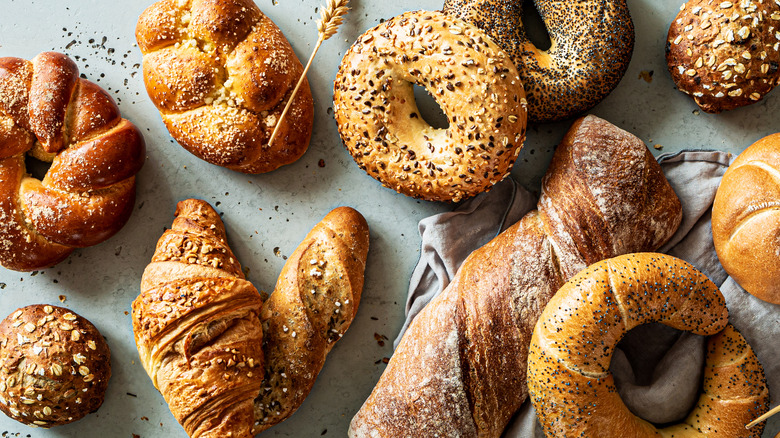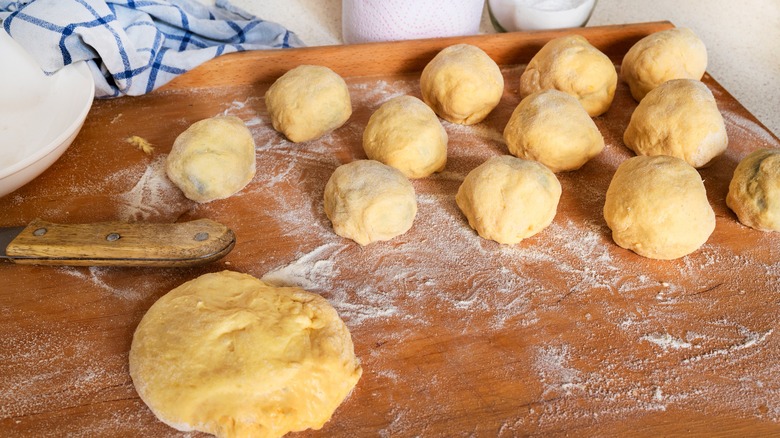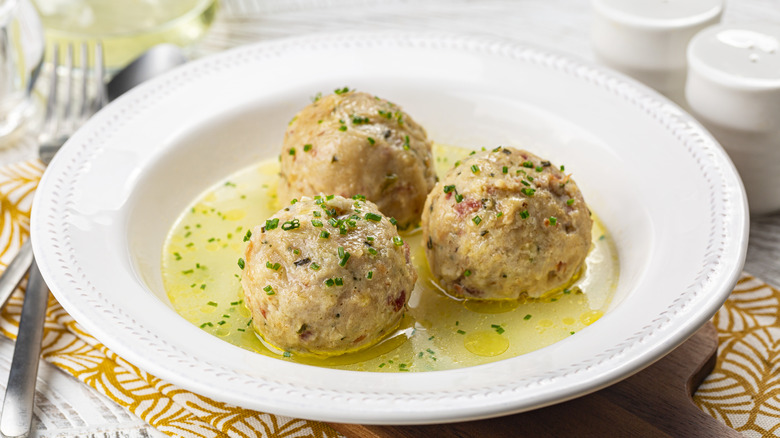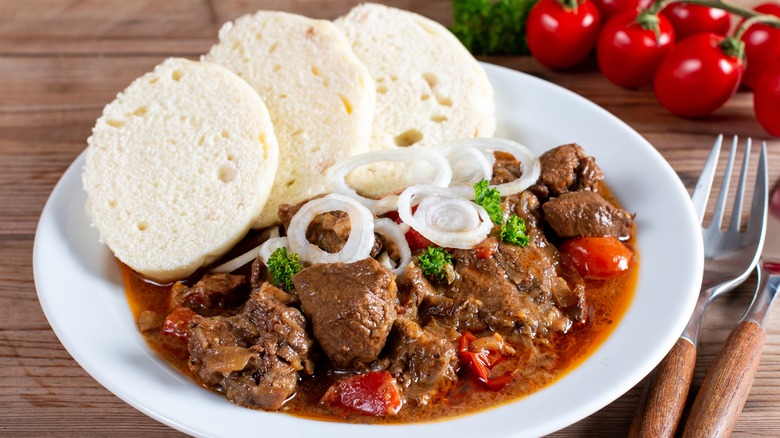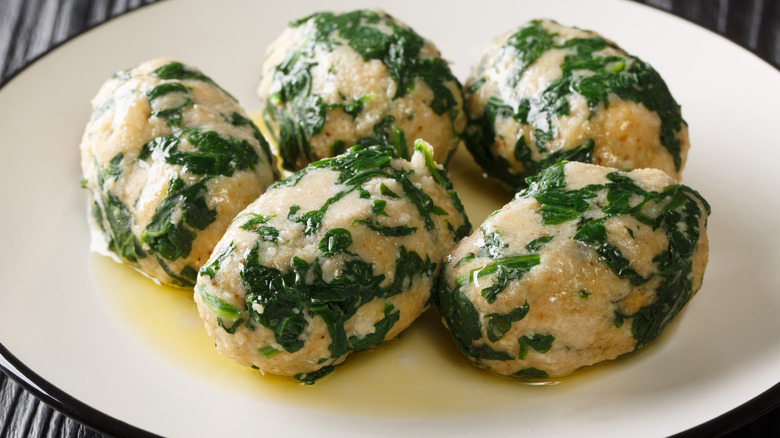The Humble Dish You Can Make With Stale Bread
It happens to all of us: You come home with a beautiful, freshly-baked loaf of bread, ready to turn it into crispy avocado toast or gooey grilled cheese. Next thing you know, the loaf is a week old and as hard as a rock.
Fortunately, stale bread is a prime ingredient in a wide variety of dishes. You probably already know that you can turn stale bread into french toast, bread pudding, or croutons. Stale bread is actually preferable for some foods, like Thanksgiving stuffing. The dry texture does a better job of soaking up liquids, and the bread won't get as soggy as it would if it were fresh.
If you're out of ideas or want to try a new way to use up that week-old brioche, though, consider trying your hand at bread dumplings. As The EU's Terminology Coordination explains, bread dumplings are a Central and Eastern European classic. While recipes vary from country to country, the basic recipe generally consists of stale bread, egg, and milk or water for binding. The ingredients are formed into small balls and boiled in water.
Some recipes include yeast or other leavening agents, and most feature spices or seasonings for extra flavor. Many kinds of bread dumplings, like the Czech houskový knedlík, are traditionally served with sauces (via Cook Like Czechs).
What defines a dumpling?
What makes bread dumplings "dumplings?" That's a tricky question: As it turns out, the definition of "dumpling" is pretty shaky.
Definitions from Cambridge Dictionary and Mirriam-Webster agree that dumplings are typically small pieces of dough, either boiled, steamed, or fried rather than baked. But other than that, just about anything goes. Dumplings can be either sweet or savory and may or may not have fillings. Their dough can be made from a wide variety of ingredients.
While some dumplings are decadent and complex, most dumplings have humble origins.
As professor and food historian Frederick Douglass Opie told NPR, dumplings often served as a way to use up scraps when food was scarce. Opie noted that peasants, subsistence farmers, or proletarians (those who worked for a wage) made dumplings to really stretch their money and save on food costs.
Bread dumplings may not look like Chinese baozi or Italian gnocchi, but they still share a connection. For cultures worldwide, dumplings serve as a form of comfort food, and bread dumplings are no exception.
When the Los Angeles Times asked cookbook author Andrea Nguyen to define "dumpling," she championed embracing the ambiguity. She thinks that because every culture has a form of dumpling, that food should be a bridge to unite people, so it's important to not get hung up on small details. Simply put, a dumpling is a dumpling — whether it's steamed day-old bread or a soft bun filled with spiced meat.
German bread dumplings
German bread dumplings, called "semmelknödel" or just "knödel," are round dumplings most commonly found in the Southern German region of Bavaria. 196 Flavors explains that semmelknödel are made by mixing bread crumbs with eggs and milk, then forming the mixture into balls and cooking the dumplings in simmering water. While flavorings vary by region, popular add-ins include bacon, onion, parsley, and nutmeg. The dumplings are often eaten with gravy or soaked in soups.
The Daily Beast notes that matzo balls, the iconic Jewish delicacy, most likely originated from German knödel (though the exact origins are up for debate). German Jews in the middle ages adapted the recipe to fit kosher diets, swapping leavened bread for Passover-friendly matzo and ditching the bacon.
Still, many recipes call for classic knödel ingredients, like parsley and nutmeg. Matzo balls — called "kneidlach" in Yiddish — spread through Ashkenazi communities throughout Europe. Later, Jewish immigrants brought the recipe to the United States where they became known as matzo balls.
Czech bread dumplings
Cook Like Czechs explains that "houskové knedlíky," which translates directly to "bread dumplings," are a staple of Czech cuisine. Rather than making a dough from bread crumbs, like German dumplings, Czech bread dumplings are made from cubes of stale bread worked into a simple dough with minimal seasonings. Czech dumplings vary from their German cousins in shape, too. In contrast to the round shape of German dumplings, the dough is formed into long loaves. These loaves are either boiled or steamed, then sliced like bread. Czech dumplings are typically made with a leavening agent; some versions call for baking powder while others use yeast.
Czech bread dumplings are often eaten doused in sauce and served as a side dish with meats like pork, duck, goose, or chicken. They're also used to sop up soups and stews (per Cook Like Czechs). Sometimes, the slices are fried and served as charcuterie with meats and cheese.
Italian bread dumplings
Chef Bike Ski writes that bread dumplings resembling potato gnocchi can be found in Italy, especially in the Trentino region. These dumplings are made from a dough of bread crumbs and spinach, kale, or swiss chard. The dough is mixed with spices and seasonings, formed into balls, and boiled in water. The dumplings are traditionally served with a sauce made of browned butter and sage.
According to legend, these bread dumplings were served to priests in the middle ages. The priests scarfed them down so quickly that they choked — earning the dumplings the name of "strangolapreti," which literally translates to "priest stranglers." However, Italian bread dumplings go by different names according to region. In some parts of Italy, the word "strangolapreti" refers to potato gnocchi; in others, it refers to a type of pasta. Splendid Table notes that Italian bread dumplings are sometimes called "gnocchi verdi," which means "gnocchi with greens" or "ravioli gnudi," which translates to "naked ravioli."
